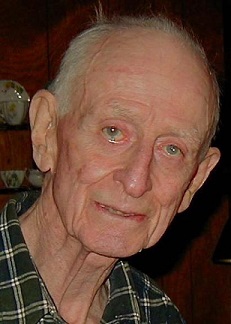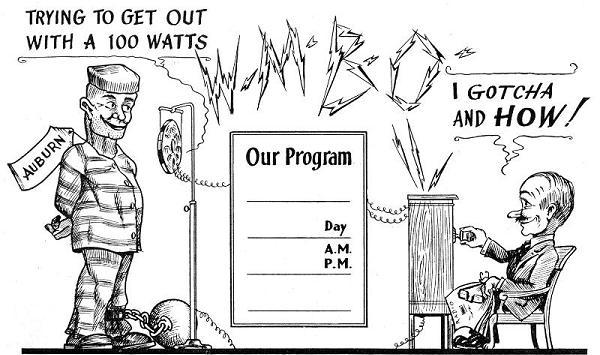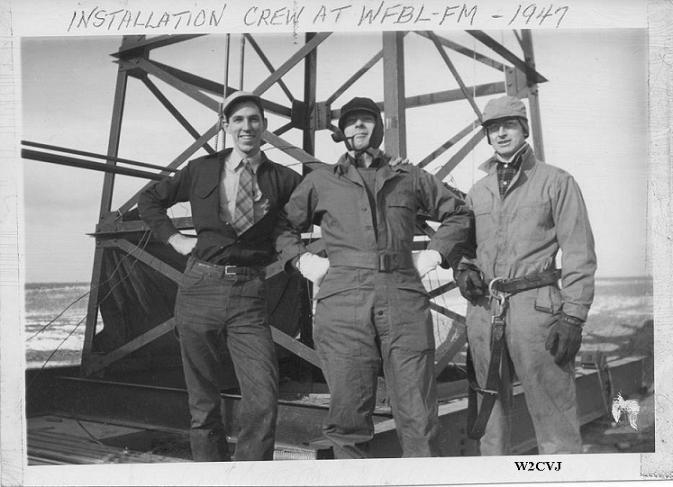 |
Donald F. 'Don' Langham Raquette Lake, NY QCWA #32674 Chapter 29 |
Donald F. Langham, 101, of Raquette Lake died October 6, 2010 at the Lutheran Home, Clinton, where he had resided since January 2009. He was born March 9, 1909 in Auburn, a son of Frederick and Elizabeth (Daniels) Langham.
Don graduated from Auburn High School with the Class of 1927. After working for the City of Auburn, he was employed by radio stations WMBO, WAGE and WFBL as a communications electronics technician. He eventually moved to Syracuse and began working at what would become WTVH-5, using his expertise to help in setting up the area's first television station.
Mr. Langham was united in marriage with Mary Elizabeth Chappel on September 17, 1932 in Auburn. He entered the U.S. Army in 1943 and served as a radio engineer stationed on Oahu, HI following the attack on Pearl Harbor. He was awarded the WWII Victory Medal, the Meritorious Service Unit Award and the Pacific Theater Campaign Ribbon prior to his honorable discharge in 1946 at the rank of captain. Mrs. Langham passed away in 2002. Donald retired from the television station in 1960 and moved to Raquette Lake, where he owned and operated The Antlers until 1967. He then operated North Point Cottages until retiring in the mid-1970s.
Don was a member of the Raquette Lake Fish & Game Club, American Legion Post 1402 (Inlet), and the Raquette Lake Volunteer Fire Department, where he also served as treasurer. He was an elder at the Raquette Lake Chapel and enjoyed amateur radio, operating station W2CVJ. Don enjoyed being outdoors, hunting, fishing or playing golf. His many friends knew he would seldom miss the opportunity for a good game of pitch.
He is survived by a daughter, Nancy L. Langham of Old Forge; a son, Frederick A. Langham and his wife, Barbara of CA; two nieces and two nephews. In addition to his wife, he was predeceased by a brother, R. Meredith Langham.
The family would like to thank the staff at Helping Hands Caregivers of Hamilton County, the staff on the Valley Crest Unit of the Lutheran Home in Clinton , and Drs. Mark Webster, Stephen Culver, and Anthony Palumbo for the exceptional care they gave Don. His funeral will be Tuesday, October 26 at 2:00 p.m. at Niccoll's Memorial Presbyterian Church, Old Forge, with the Rev. Lawrence Bartel officiating.
Interment with military honors will follow in Riverview Cemetery. There are no calling hours. In lieu of flowers, please consider donations in Don's memory to the Raquette Lake Chapel, Raquette Lake Volunteer Fire Department, or the Raquette Lake Fish & Game Club. Arrangements are under the direction of Dimbleby, Friedel, Williams & Edmunds Funeral Home, Old Forge.
I got my license in 1926 when I was 17 years old and in high school. The call was 8CVJ at that time.
 Hot Station: I started working at WMBO in Auburn in 1930. It was a small 100-watt station but not a bad place to work. The official slogan of the station at that time was "The Voice of the Finger Lakes." I'm not sure whether the call letters had any particular significance, but to me they stood for We May Burn Out. The station was first located on the third floor of the Hislop Building. That burned in 1932. The station relocated to the 9th floor of the Masonic Building and that burned 8 months later. In both cases we were able to get out without any injuries. The second time we lost the transmitter and everything so the station was off the air for awhile until the station relocated to the Metcalf Building. This was a month before I was to get married - we went ahead and got married anyway but lived pretty frugally for awhile.
Hot Station: I started working at WMBO in Auburn in 1930. It was a small 100-watt station but not a bad place to work. The official slogan of the station at that time was "The Voice of the Finger Lakes." I'm not sure whether the call letters had any particular significance, but to me they stood for We May Burn Out. The station was first located on the third floor of the Hislop Building. That burned in 1932. The station relocated to the 9th floor of the Masonic Building and that burned 8 months later. In both cases we were able to get out without any injuries. The second time we lost the transmitter and everything so the station was off the air for awhile until the station relocated to the Metcalf Building. This was a month before I was to get married - we went ahead and got married anyway but lived pretty frugally for awhile.
I left WMBO in Auburn in March 1935 where I had been an engineer and announcer for 5 years for WFBL. I became a Control Room operator at WFBL where Al Marcy was Chief Engineer. Others in the Control Room were Bob Aller, and Walt Stonger who later became transmitter engineer along with Earl Williams and Tommy Hale at Collamer. While at WFBL I also was involved in many of the Special Events and built much of the portable-mobile equipment in use. Until WFBL went to a vertical radiator in 1938, the transmitting antenna at the Collamer site was a cage feedline suspended from an antenna strung between two 200' towers. It was interesting in that when they went to the vertical in 1938, a big advertising point was it's omnidirectional coverage. Later on, when they went back to directional coverage they also touted that as a real improvement and hoped that their advertisers had short memories.......
Remote Broadcasts: WFBL had several specially-constructed mobile transmitters that could be used to broadcast a remote event back to the studios. One was a truck and the other was a trailer. Both were custom built for the station - I built a lot of the electronics. The truck used the WAUQ call and the trailer used WGBE. The station had another call that wasn't used - WGBH. That call is now used by a PBS station in Boston.
The 1937 Flood: In the spring of 1937 the Ohio River flooded badly. Sam Woodworth, never one to miss a chance to demonstrate his station's equipment, volunteered the use of the mobile transmitters and the Army Signal Corps took him up on it. So we got in the truck and drove to Cairo, Illinois. The Army Signal Corps at that time used hand-cranked stations that were really only good for CW because of their low power. The Sergeant in charge of communications took his first look at our setup and his eyes lit up he was so impressed. So we would pass information back and forth between the local low power stations and stations in Louisville, Cincinnati, and so forth. We were there for two weeks.
Angry Firefighters: The roads back in those days weren't that good and we took mostly back roads driving home. We were driving past a farm and we saw the farmhouse was on fire. Some wood stacked up against it had caught fire so we stopped and ran over to the farmhouse. There was no one inside so we grabbed the two fire extinguishers that we carried in the van and managed to put the fire out. Just as we finished, the local fire department pulled up. Instead of congratulating us they were pretty mad. The farmhouse was abandoned and they had set the fire to practice on. We got out of there pretty fast.
War Years: During the war I served as a Lieutenant in the Army Signal Corps beginning in 1943. WFBL helped out by publishing a monthly newsletter that they mailed to all their former employees that were in the service. We contributed write-ups to the newsletter and it was much enjoyed. After WWII, much of which war spent in the Pacific area under Colonel Al Marcy, believe it or not! I returned to WFBL in 1946 and was just in time to be involved with the new FM station on Pompey Hill. After it went on the air I became one of its transmitter operators, this was 1947.
 No Loitering: During the 40's the WFBL offices were open 24 hours a day but the public wasn't supposed to be there after 9:30p.m. With so many of us in the service the station had to hire a number of new technicians and announcers. One young announcer hadn't worked at the station for more than a couple of days when he went into the offices at 10:00p.m. one night and saw this portly gentleman relaxing in a chair with a cigar. He really chewed the guy out and told him to get out of there or he'd call the cops. Turns out that the gentleman was Sam Woodworth - Sam just got up and went in and sat in his Manager's Office.
No Loitering: During the 40's the WFBL offices were open 24 hours a day but the public wasn't supposed to be there after 9:30p.m. With so many of us in the service the station had to hire a number of new technicians and announcers. One young announcer hadn't worked at the station for more than a couple of days when he went into the offices at 10:00p.m. one night and saw this portly gentleman relaxing in a chair with a cigar. He really chewed the guy out and told him to get out of there or he'd call the cops. Turns out that the gentleman was Sam Woodworth - Sam just got up and went in and sat in his Manager's Office.
After a hard winter in which I became marooned at the FM station for 5 days until they flew me out, I applied for the Chief's job at WAGE where former Chief Engineer Charlie Brannon was leaving. I got it! WAGE already had the four towers and a small transmitter building located on Old Liverpool Road. The antenna system was impressive, the original ground system was very extensive and included copper sheets about 20' square at the base of each tower for the radials to connect to. They were in the process of building a new transmitter building and going from 1KW to 5KW with a new Western-Electric "state of the art" Daugherty low-level mod. A real "Frankenstein" we called it! Charlie Brannon had already ordered it and it was on hand so I got the job of installing it along with a 4-tower antenna array and tuning house. Fortunately I had a FB Ole Timer to work with me. Bill Cheley-W2JY. Bill was already on the staff when I arrived.
The building had been designed to accept the big WE transmitter with channels in the concrete floor for the wiring. The wiring charts were easily readable and Bill Cheley and I had little trouble connecting them, one of us at each end. One demanding job was installing the large change-over relay to switch over to the 1KW Collins for night-time operation. Originally the feedlines from the transmitter building to the towers were 5 or 6-wire open cage lines which were tough to keep tuned up - especially in the winter. I had the job of converting these to coaxial cable which had to be nitrogen fed.
The Western Electric rig at WAGE was quite large and took up a lot of space in the building. Since the design of the WE Transmitter was innovative and new to all of us, an WE engineer was sent out to help us when we had everything ready for the tuning up. His last name was Brown and he seemed to be well-versed in the tune-up procedure which involved the use of an impedance bridge. Once it was running we never had much trouble with it. The circuitry was designed so that things ran really cool which was one of their selling points. Finals were air-cooled of course.
In 1953 the Meredith Publishing Company bought WAGE and I was picked to go to WHEN-TV on Court Street as "Director of Operations". Actually I had no interest in getting into TV but the General Manager of the TV station was Paul Adanti-W8AFG who I helped get into Ham radio in our Auburn days, where he was born and brought up, same as me. The transmitter was located on Court Street and had just gone on the air several months earlier. They had really rushed to get the station on the air and be the first Syracuse TV station. The rig was really thrown together and it was tough keeping it on the air. Anyway, I stayed there a few years but finally quit to move to the Adirondacks where I already had a hunting lodge and other resort property. It was 1958. I returned for a couple of winters to fill in at WHEN radio while I was waiting for good weather to finish our new house up here.